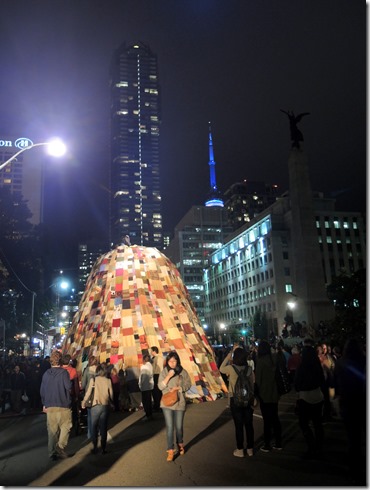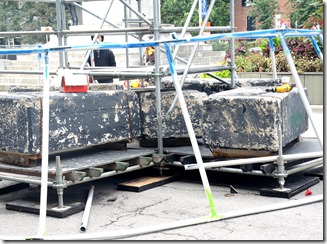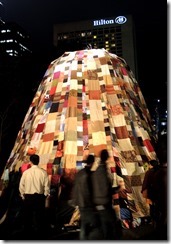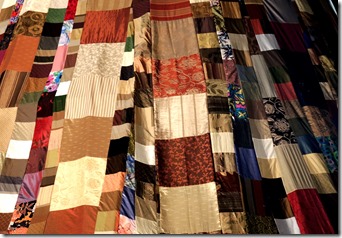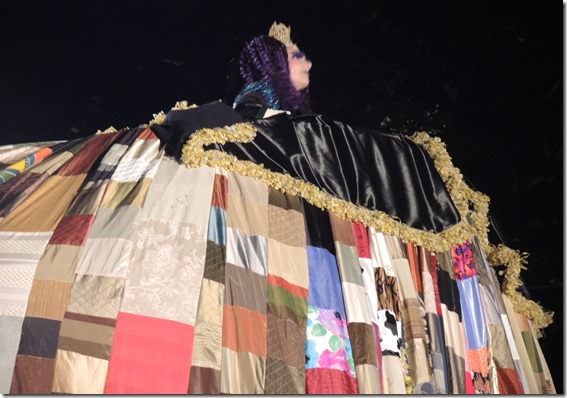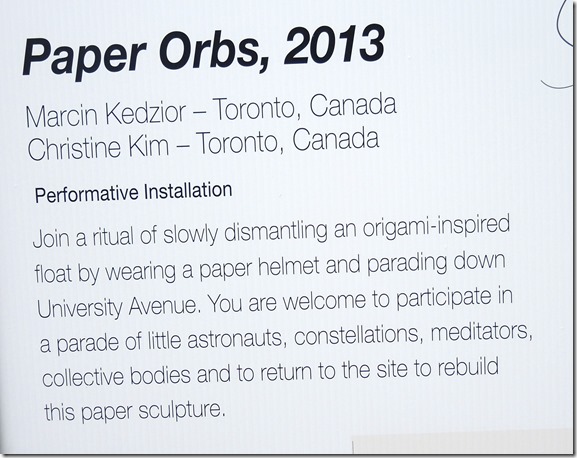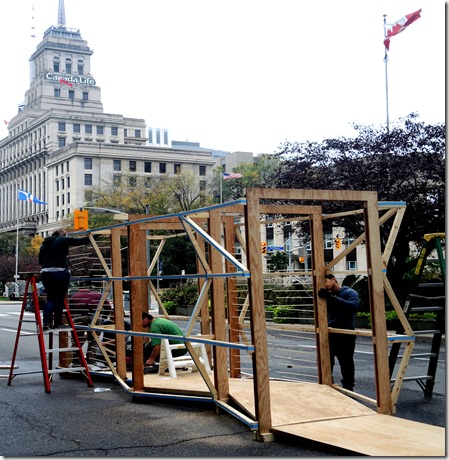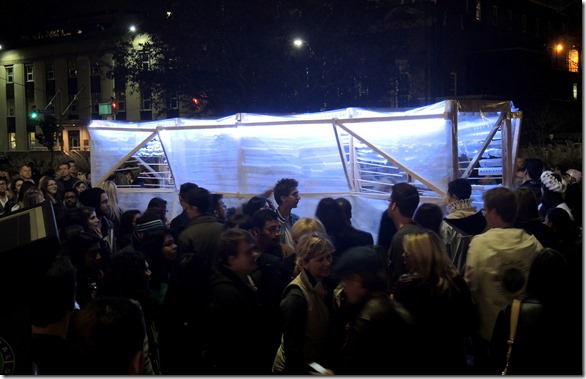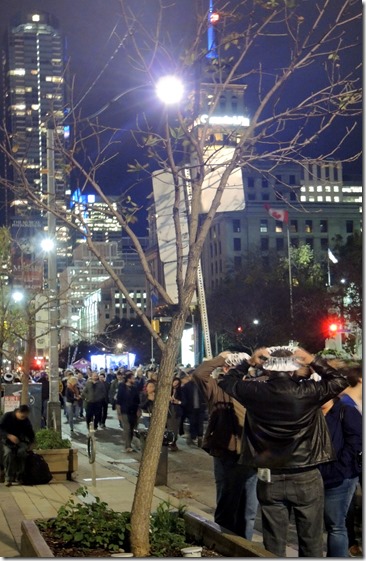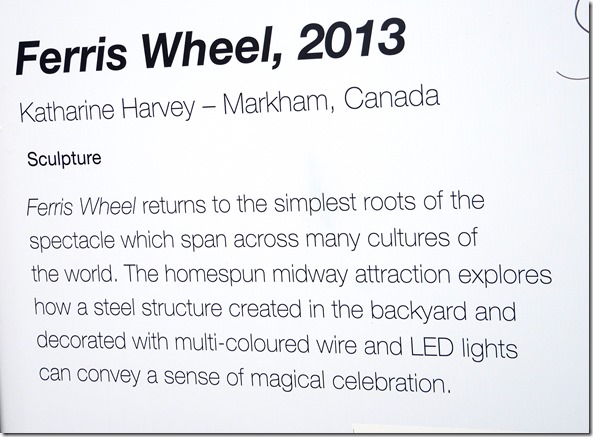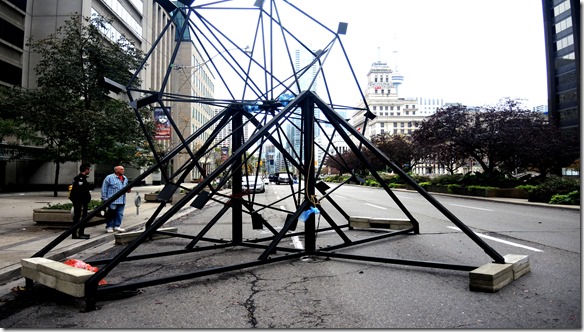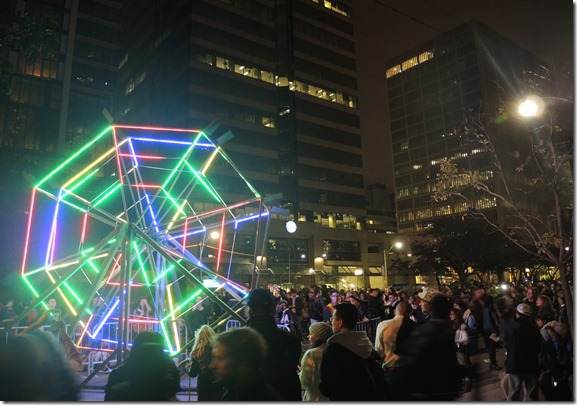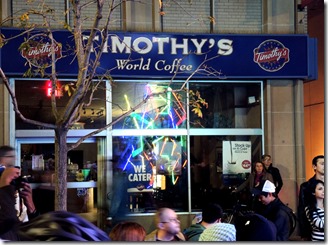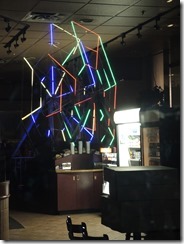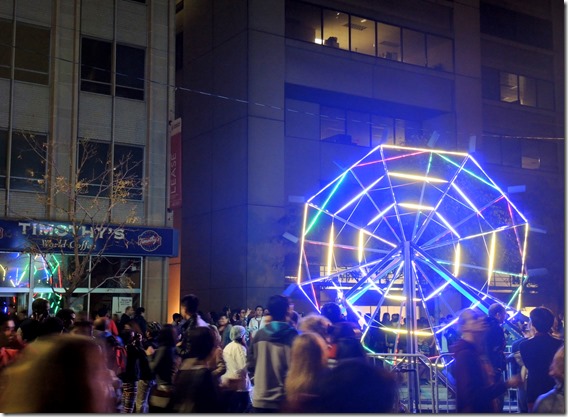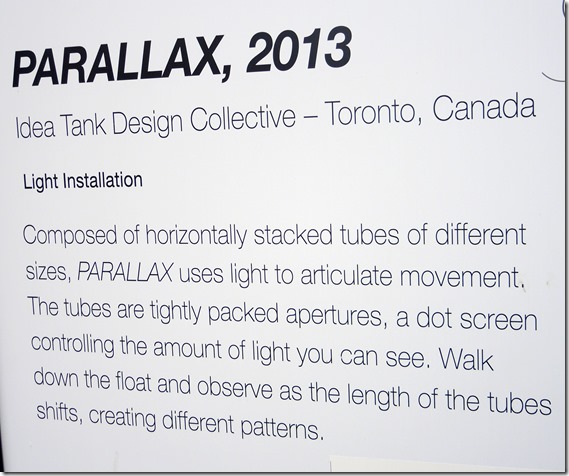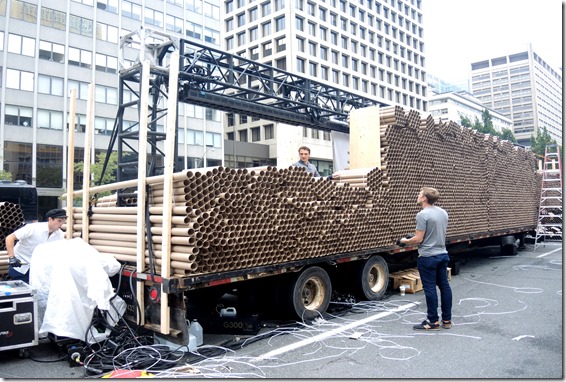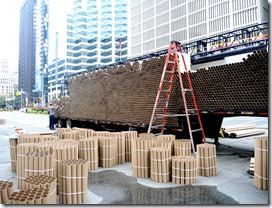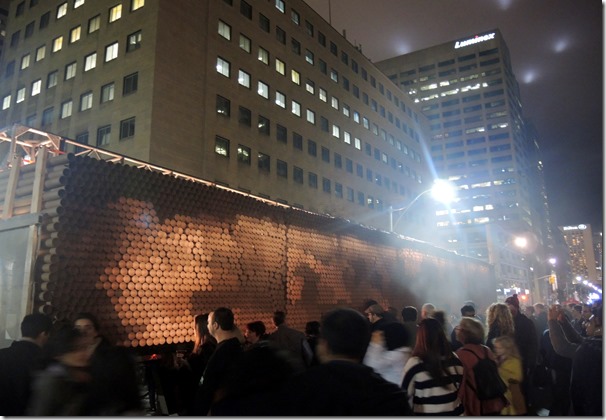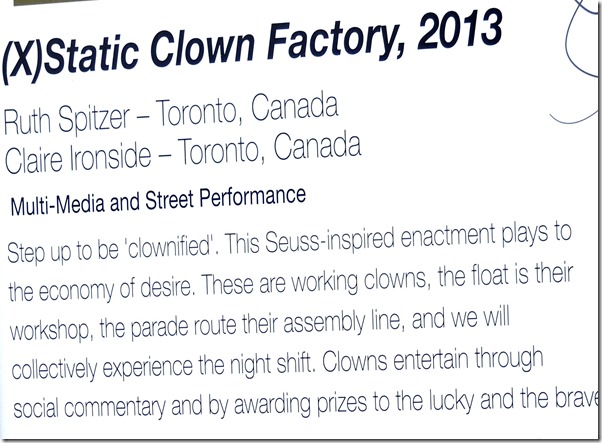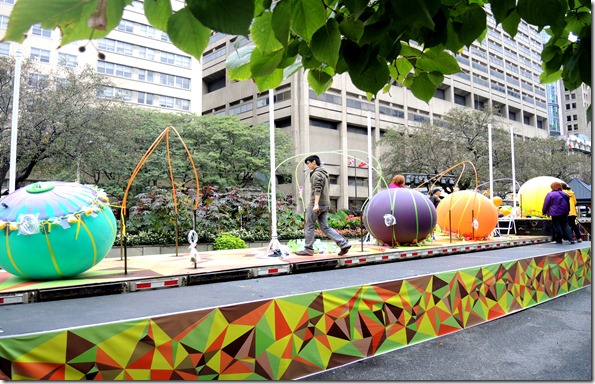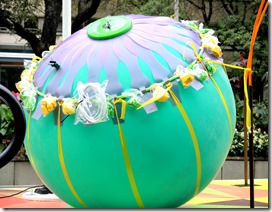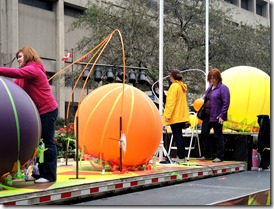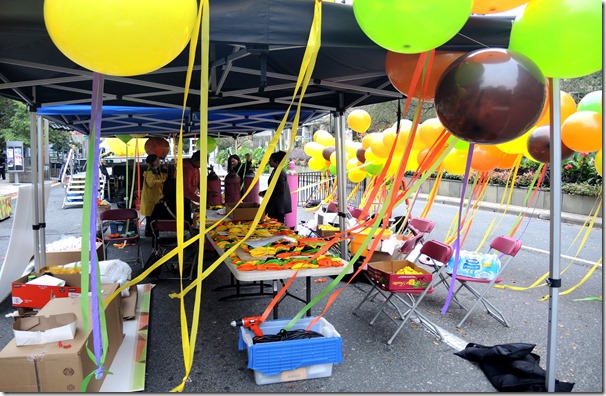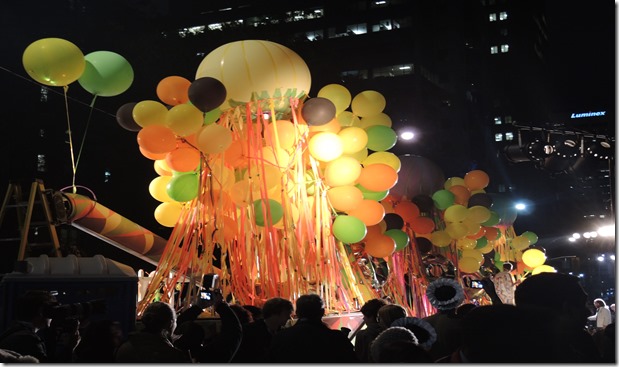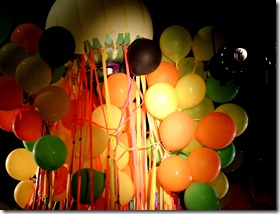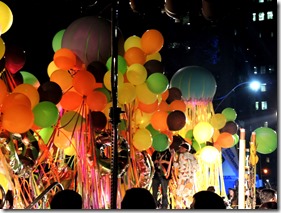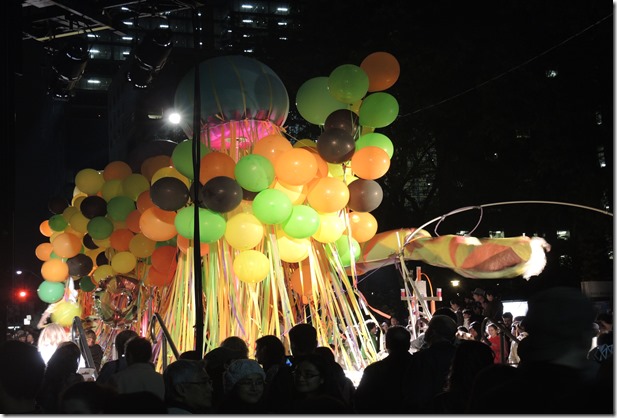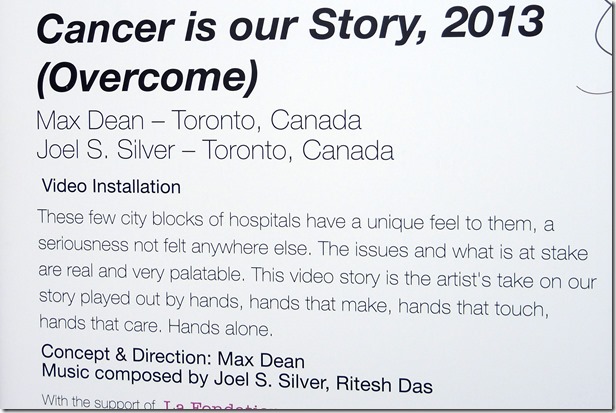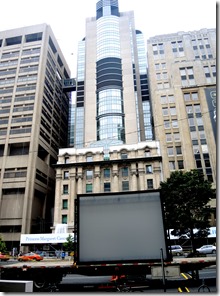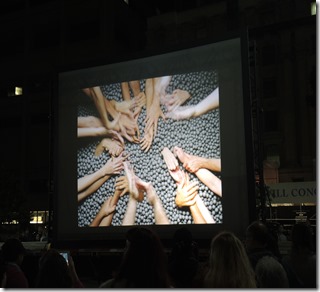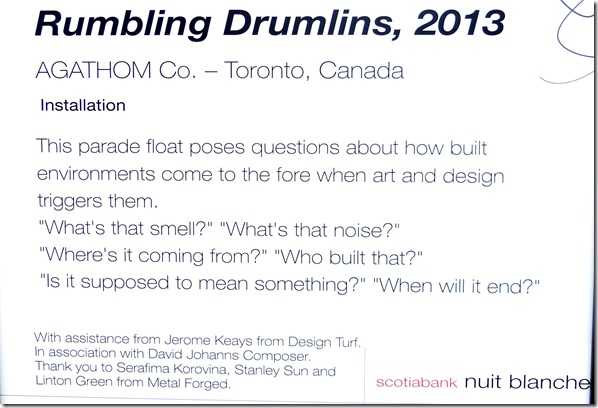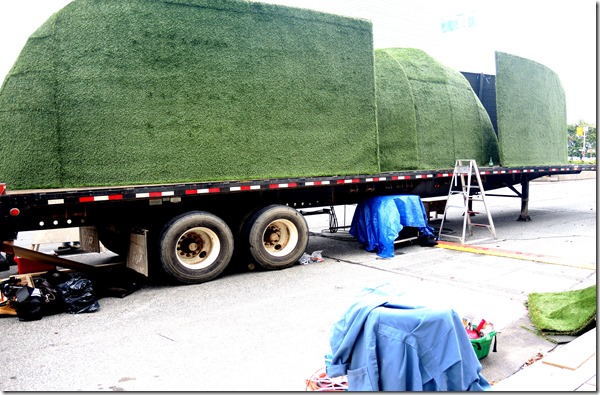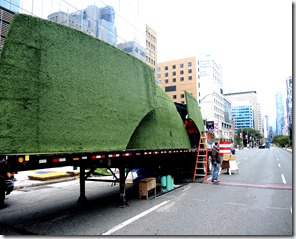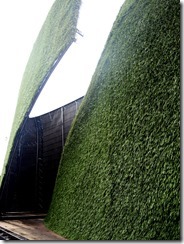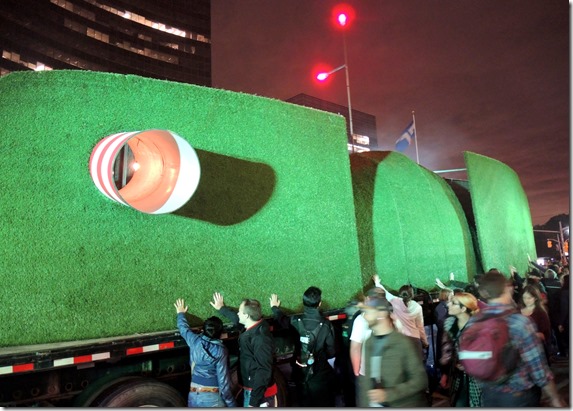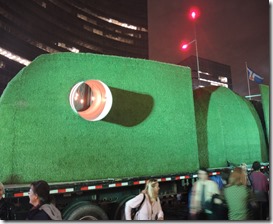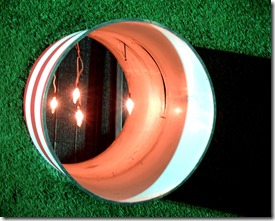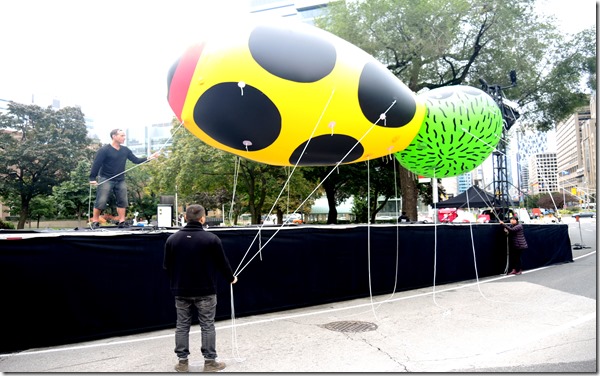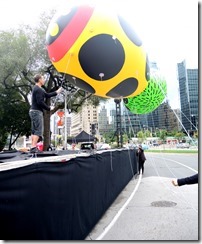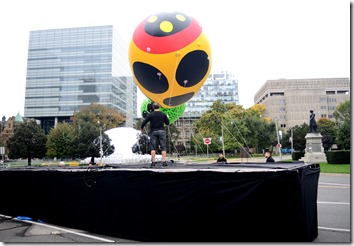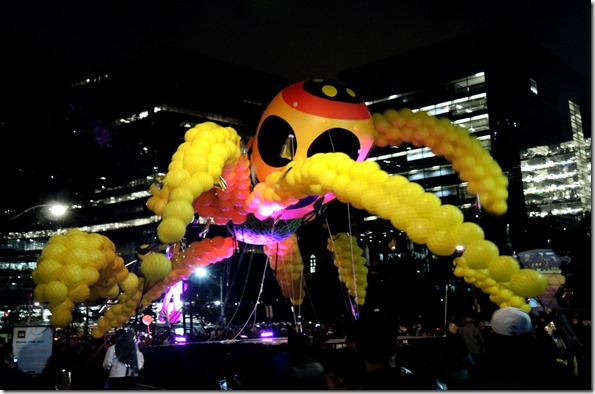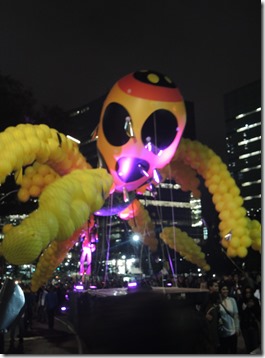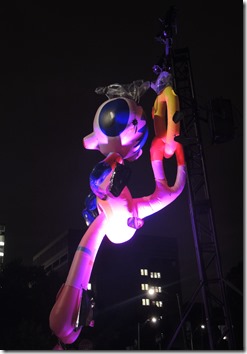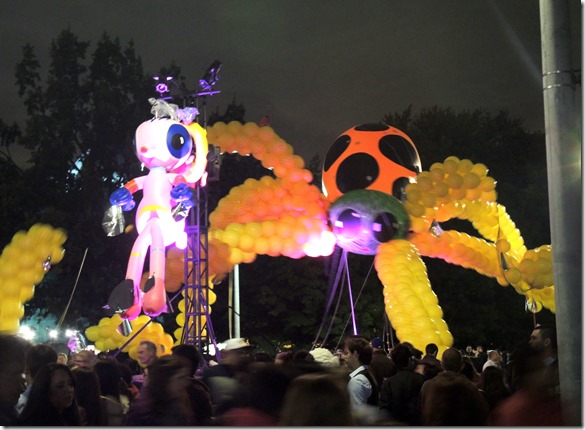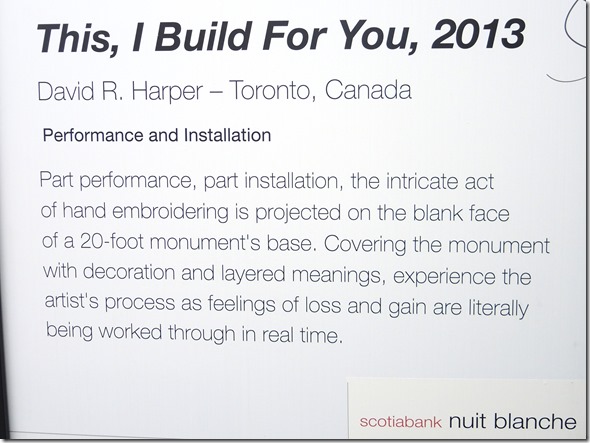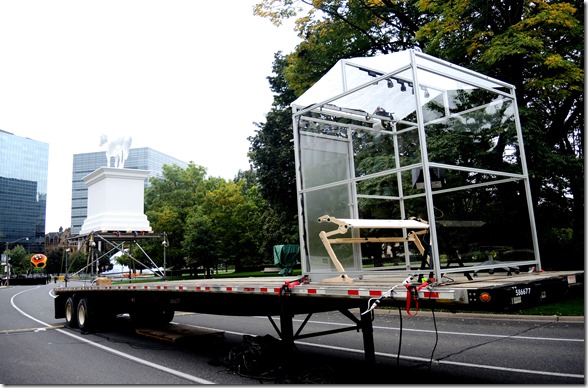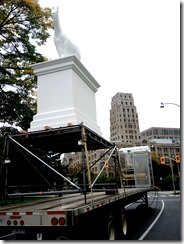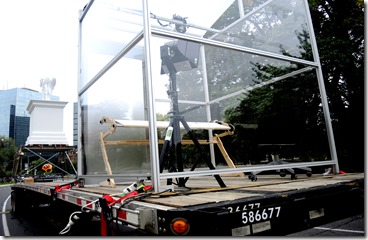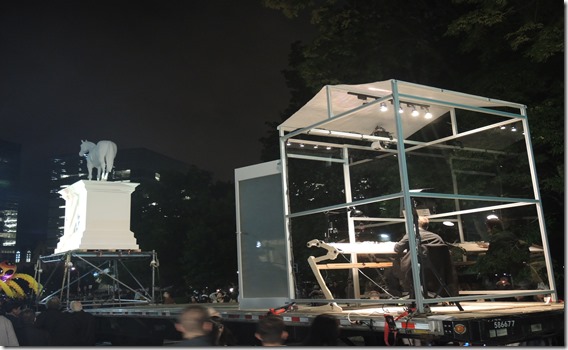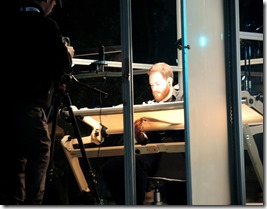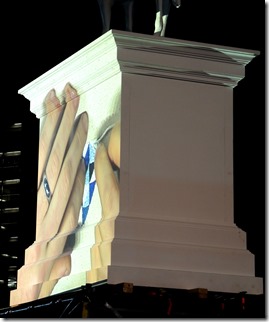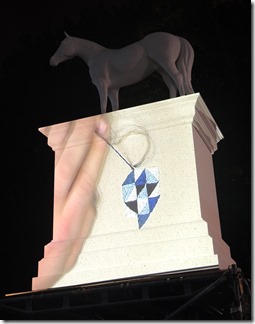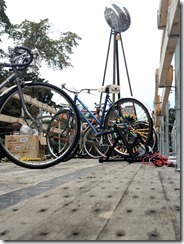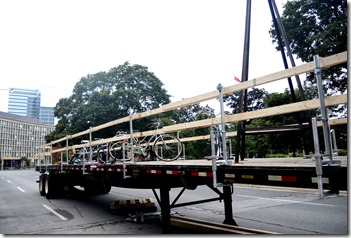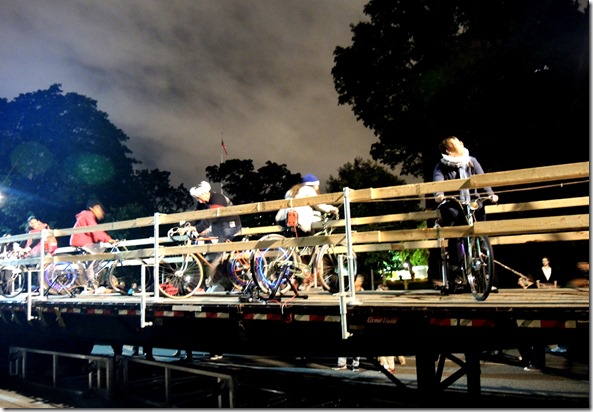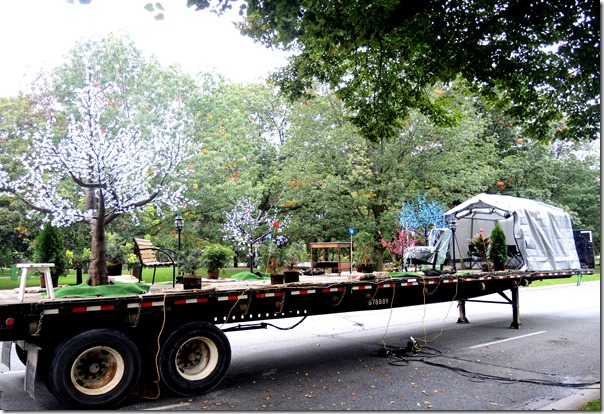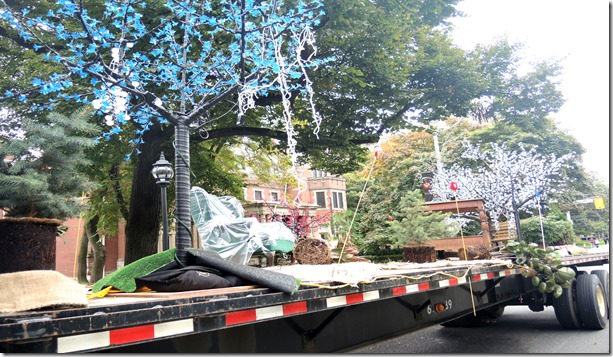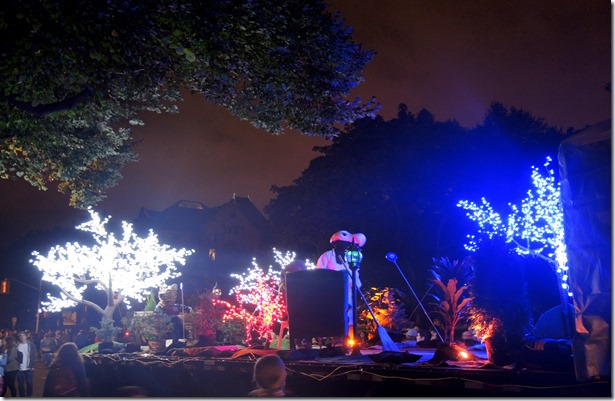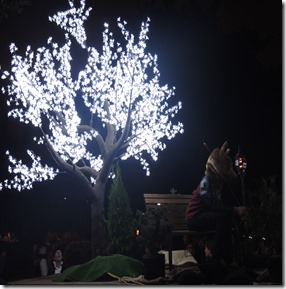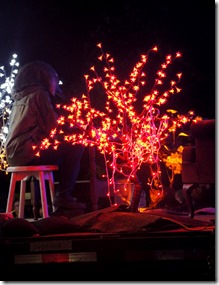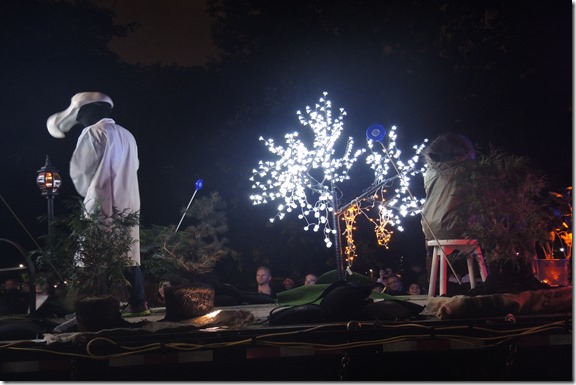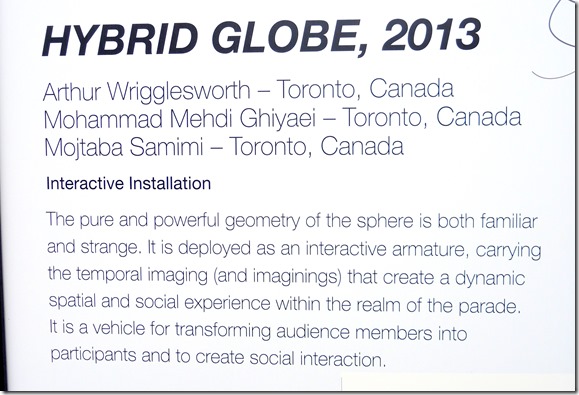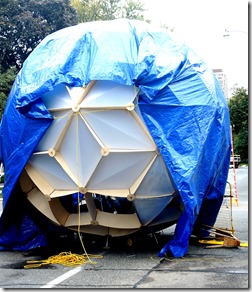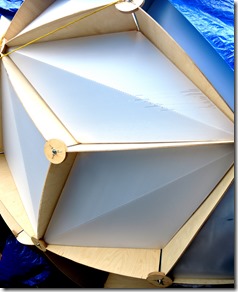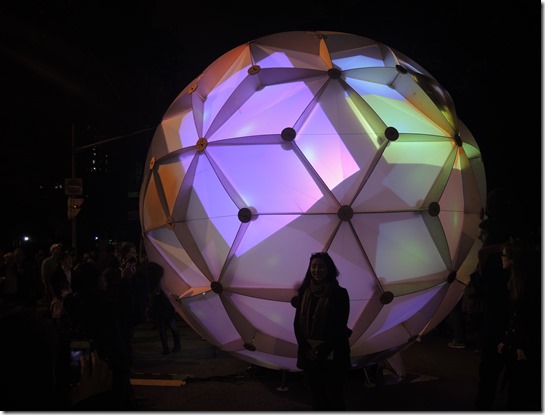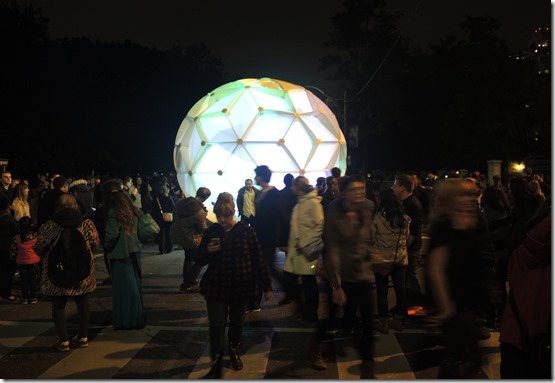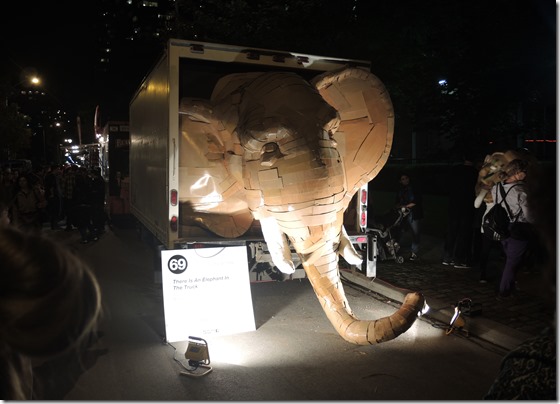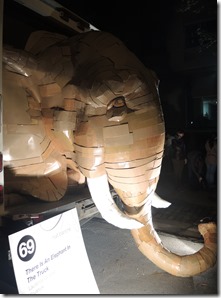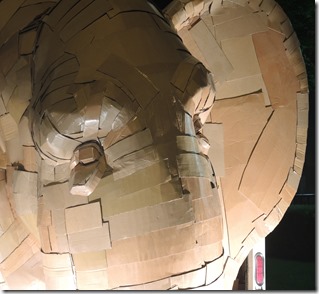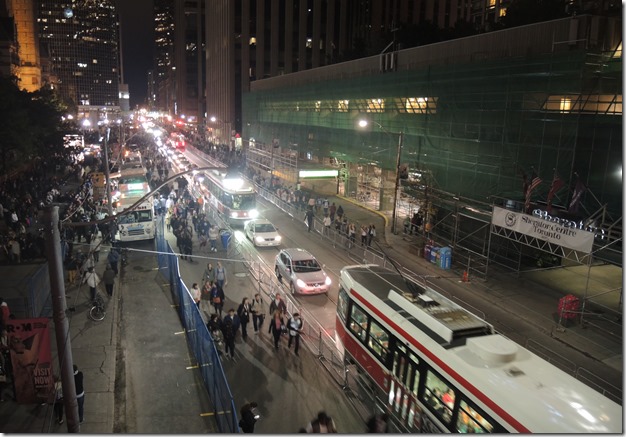This year at Nuit Blanche, many of the visual art installations were on University Avenue, which was closed to vehicle traffic from Queen West to Bloor Street. As this avenue is one of the city’s popular routes for parades, this section of Nuit Blanche was entitled “Parade.” The art works were either on flatbed trucks, similar to those employed by floats for parades, or mounted on metal or wooden frames. The first installation on the route was entitled “Queen of the Parade.” It was on a tall metal frame, and the “Queen” climbed to her perch from inside the structure. It was located at Queen Street West and University Avenue.
The base of the structure and the frame for “Queen of the Parade.”
The frame was covered in what appeared to be an enormous quilt.
“The Queen” at the top of the tower, regally gazing out over her admirers below.
“Paper Orbs” was also constructed on a wooden frame. When completed, the frame supported a booth where hats inspired by origami were distributed.
The structure for “Paper Orbs” when it was being constructed.
“Paper Orbs” after dark, the blue lighting inside the structure casting an eerie glow.
People wearing hats from “Paper Orbs.”
“The Ferris Wheel,” which was wind powered. View gazes south on University, the Canada Life Building in the background.
The Ferris Wheel at night.
Reflections of the Ferris Wheel in Timothy’s Coffee Shop window.The shop is on the east side of University Avenue.
The Ferris Wheel and the reflections from its lights in the window of Timothy’s.
The large flatbed truck being stacked with cardboard tubes to create “Parallax.”
The cardboard tubes employed in the art work entitled “Parallax.”
“Parallax” after dark, surrounded by admiring viewers.
The flatbed being prepared for “Static Clown Factory.”
Balloons being inflated with helium gas to create this float on Parade.
“The Static Clown Factory” at night in all its colourful glory. It resembled a float from a Mardi Gras parade.
This display attracted great crowds. It was positioned near the Princess Margaret Hospital, which is Toronto’s main facility for cancer research and treatment. The visual on the screen was symbolic of the fight against the disease, with many hands contributing to the fight.
This float achieved its stated purpose. Viewers were puzzled and wondered what it represented. Some felt that it resembled a submarine.
At night, the shape appeared ominous yet attractive. People wanted to touch it as they examined its texture and shape.
On the morning of the event, this flatbed gave little indication of the colourful float that the artists had designed.
At night, the giant spider emerged. People lingered to marvel at this colourful creation.
This was one of the most interesting floats on Parade. Viewing it during the morning, I was unable to visualize what it was.
All I could see was a booth enclosed by glass, and a monument with a horse mounted on it.
At night, when the float was in operation, a young man sat in the booth and embroidered a design on a blank piece of cloth. His work was then transferred visually to the base of the monument that had a horse mounted on it. It could then be viewed by the crowds.
The artists embroidering on the piece of cloth.
The embroidery seen on the base of the monument, which acted as a screen. The artist’s hands can be seen as he embroidered.
This was the scene in the morning, the bicycles having been placed on the flatbed.
Participants lined up to ride one of the bicycles. Their pedalling generated power to operate the lights and the sound system.
In the morning light, the scene created on the flatbed appeared interesting.
At night, it was colourful. A person in a white doctor’s coat and wearing a mask, walked through the scene.
The lights on the trees on the float.
The figure walking about on the float.
These pictures were taken about 11 am on Saturday morning.
At night, the globe was magical.
This art work was created with cardboard strips.
This final view is of Queen Street West, gazing east toward Yonge Street, near midnight on the evening of Nuit Blanche. It was taken from the bridge that crosses the street from Nathan Phillips Square.
To view the Home Page for this blog: https://tayloronhistory.com/
To view the previous post about Nuit Blanche 2013:
https://tayloronhistory.com/2013/10/07/afterglow-from-nuit-blanche-2013/
To view other posts about the history of Toronto and its buildings:
The Arts and Letters Club, the former St. George’s Hall at 14 Elm Street.
The Ellis Building on Adelaide Street near Spadina Ave.
The Heintzman Building on Yonge Street, next to the Elgin Theatre
The tall narrow building at 242 Yonge Street, south of Dundas
https://tayloronhistory.com/2013/07/10/torontos-architectural-gems242-yonge-st-south-of-dundas/
Toronto’s first Reference Library at College and St. George Streets.
The Commodore Building at 315-317 Adelaide St. West
The Graphic Arts Building (condo) on Richmond Street
The Art Deco Victory Building on Richmond Street
The Concourse Building on Adelaide Street
The old Bank of Commerce at 197 Yonge Street
The Traders Bank on Yonge Street—the city’s second skyscraper
https://tayloronhistory.com/2013/05/22/torontos-architectural-gemstraders-bank-on-yonge-st/
Toronto’s old Union Station on Front Street, built in 1884
https://tayloronhistory.com/2013/05/18/torontos-lost-architectural-gemsthe-old-union-station/
St. Andrew’s Presbyterian Church at King and Simcoe Streets.
https://tayloronhistory.com/2013/05/13/torontos-architectural-gemshistoric-st-andrews-on-king-st/
The row houses on Glasgow Street, near Spadina and College Streets
https://tayloronhistory.com/2013/05/10/torontos-architectural-gemsrow-houses-on-glasgow-st/
The bank at Queen and Simcoe that resembles a Greek temple
The cenotaph at Toronto’s Old City Hall
https://tayloronhistory.com/2013/04/09/torontos-architectural-gemscenotaph-at-old-city-hall/
The magnificent Metropolitan Cathedral at King East and Church Streets
https://tayloronhistory.com/2013/04/02/torontos-architectural-gemsmetropolitan-cathedral/
St. Stanislaus Koska RC Church on Denison Avenue, north of Queen West
The historical St. Mary’s Church at Adelaide and Bathurst Streets
The Bishop’s (St, Michael’s) Palace on Church Street, Toronto
https://tayloronhistory.com/2013/03/02/torontos-architectural-gemsbishops-palace-on-church-street/
The Union Building at Simcoe and King Street West
https://tayloronhistory.com/2013/03/30/torontos-architectural-gemsthe-union-building-on-king-st/
The Ed Mirvish (Pantages, Imperial, Canon) Theatre, a true architectural gem on Toronto’s Yonge Street
The Waverly Hotel on Spadina near College Street.
https://tayloronhistory.com/2013/02/16/toronto-architectural-gemsthe-waverly-hotel-484-spadina/
The Art Deco Bank of Commerce building on King Street West.
The Postal Delivery Building, now the Air Canada Centre (ACC)
The Bellevue Fire Station on College Street
https://tayloronhistory.com/2013/02/14/torontos-architectural-gems-bellevue-fire-station/
The Bank of Nova Scotia at King and Bay Streets
Toronto’s old Sunnyside Beach
https://tayloronhistory.com/2013/02/01/a-pictorial-journey-to-sunnyside-beach-of-old-part-one/
https://tayloronhistory.com/2013/02/03/a-pictorial-journey-to-torontos-old-sunnyside-beach-part-two/
Toronto’s architectural gems—the Runnymede Library
https://tayloronhistory.com/2013/02/05/torontos-architectural-gems-runnymede-library/
Spadina Avenue – sinful, spicy and diverse
https://tayloronhistory.com/2012/09/28/sinfully-saucy-and-diversetorontos-spadina-avenue/
The Reading Building, a warehouse loft on Spadina Avenue
https://tayloronhistory.com/2013/01/20/torontos-architectural-gemsthe-reading-building-on-spadina/
The Darling Building on Spadina Avenue
https://tayloronhistory.com/2013/01/19/torontos-architectural-gemsthe-darling-building-on-spadina/
The amazing Fashion Building on Spadina Avenue
Toronto’s architectural gems – the Tower Building at Spadina and Adelaide Street
The Balfour Building at 119 Spadina Avenue
The Robertson Building at 215 Spadina that houses the Dark Horse Espresso Bar
An architectural gem – Grossman’s Tavern at Spadina and Cecil Streets
https://tayloronhistory.com/2012/11/08/architectural-gem-grossmans-tavern-at-377-9-spadina/Historic
History of the house that contains the Paul Magder Fur Shop at 202 Spadina
An important historic building that disappeared from the northeast corner of Spadina and College
Historic bank building on northeast corner of Spadina and Queen West
https://tayloronhistory.com/2012/12/02/torontos-architectural-gemsbank-at-spadina-and-queen-west/
History of the Backpackers’ Hotel at King and Spadina
https://tayloronhistory.com/2012/03/31/history-of-the-backpackers-hotel-at-king-and-spadina/
Hamburger corner – Spadina and Queen Streets
https://tayloronhistory.com/2012/10/10/torontos-hamburger-cornerwhere-is-it-and-why/
Lord Lansdowne Public School on Spadina Crescent
The Victory Burlesque Theatre at Dundas and Spadina
https://tayloronhistory.com/2012/09/08/the-sinful-victory-burlesque-theatre-at-dundas-and-spadina/
The Dragon City Mall on the southwest corner of Dundas and Spadina
https://tayloronhistory.com/2012/08/25/torontos-heritage-the-southwest-corner-of-queen-and-spadina/
Buildings on the west side of Spadina a short distance north of Queen Street.
History of the site of the Mcdonalds on northwest corner of Queen and Spadina
https://tayloronhistory.com/2012/08/27/mcdonalds-at-queen-and-spadina-on-an-historic-site/
A former mansion at 235 Spadina that is now almost hidden from view.
ttps://tayloronhistory.wordpress.com/2012/07/04/torontos-architectural-gems-is-this-one-a-joke/
Military hero of the War of 1812 lived near corner of Spadina and Queen West.
The Art Deco bus terminal at Bay and Dundas Streets.
Photos of the surroundings of the CN Tower and and the St. Lawrence Market in 1977
The old Dominion Bank Building at King and Yonge Street
The Canada Life Building on University and Queen Street West.
Campbell House at the corner of Queen Street West and University Avenue
A study of Osgoode Hall
https://tayloronhistory.com/2012/04/12/enjoying-torontos-architectural-gems-osgoode-hall/
Toronto’s first City Hall, now a part of the St. Lawrence Market
Toronto’s Draper Street, a time-tunnel into the 19th century
The Black Bull Tavern at Queen and Soho Streets, established in 1822
History of the 1867 fence around Osgoode Hall on Queen Street West at York Street
Gathering around the radio as a child in the 1940s
The opening of the University Theatre on Bloor Street, west of Bay St.
https://tayloronhistory.com/2012/02/24/the-opening-of-torontos-university-theatre-on-bloor-street/
122 persons perish in the Noronic Disaster on Toronto’s waterfront in 1949
Historic Victoria Memorial Square where Toronto’s first cemetery was located, now hidden amid the Entertainment District
https://tayloronhistory.com/2012/01/09/victoria-square-in-torontos-entertainment-district-is-a-gem/
Visiting one of Toronto’s best preserved 19th-century streets-Willcocks Avenue
The 1930s Water Maintenance Building on Brant Street, north of St. Andrew’s Park
Toronto’s architectural gems-photos of the Old City from a book published by the city in 1912
Toronto’s architectural gems in 1912
https://tayloronhistory.com/2012/12/04/torontos-architectural-gems-in-1912/
Toronto’s architectural gems – the bank on the northeast corner of Queen West and Spadina
https://tayloronhistory.com/2012/12/02/torontos-architectural-gemsbank-at-spadina-and-queen-west/
Photos of the surroundings of the CN Tower and and the St. Lawrence Market in 1977
The St. Lawrence Hall on King Street
https://tayloronhistory.com/2012/04/28/enjoying-torontos-architectural-gems-the-st-lawrence-hall/
Toronto’s streetcars through the past decades
https://tayloronhistory.com/2012/03/26/memories-of-torontos-streetcars-of-yesteryear/
History of Trinity Bellwoods Park
https://tayloronhistory.com/2012/04/09/the-history-and-beauty-of-trinity-bellwood-park/
A history of Toronto’s famous ferry boats to the Toronto Islands
